Back Bouncing For Steelhead: Expert Tips For More Fish
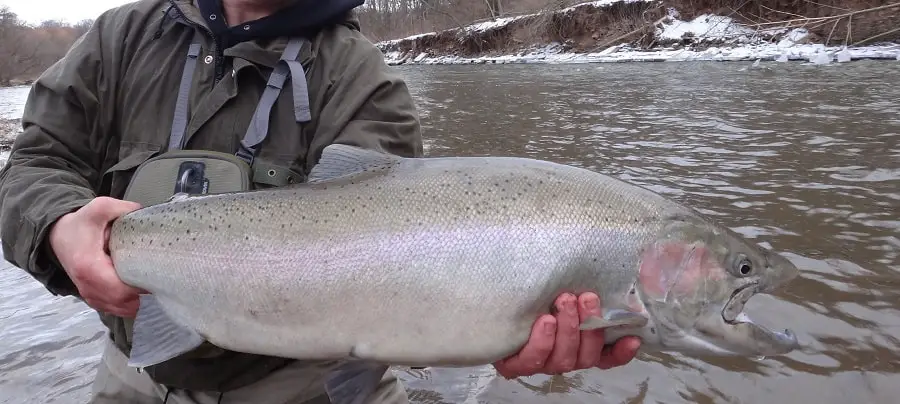
I’ve spent a good three decades mastering the art of back bouncing for steelhead. I use it when guiding, especially when dealing with certain water conditions. This technique isn’t just effective for Steelhead, but it also proves its worth with Coho salmon and King salmon.
Seasoned guides and experienced anglers use these back-bouncing strategies and setups, and if you are not using them, you are probably missing fish. I’ll walk you through all the essentials to get you started.
Understanding Back Bouncing For Steelhead
Back bouncing is an effective river fishing technique for catching steelhead in swifter or deeper rivers. The concept is simple: you drop a substantial weight along with a bait or lure to the river’s bottom. This presentation then dangles enticingly in the flow of the current.
The key to success lies in repeatedly lifting and gently lowering the weight every 5 to 20 seconds. This slowly presents your bait downstream to where the Steelhead are holding.
Back bouncing works well on West Coast rivers and the rivers around the Great Lakes, and it is equally good when back bouncing for salmon.
Mastering The Back-Bouncing Method
With the right weight, the right bait, and a proven back bouncing rig, fishing with the traditional back-bouncing technique is actually easy. Whether you’re releasing the weight from the back of your boat or casting it into your chosen fishing spot, the process remains the same.
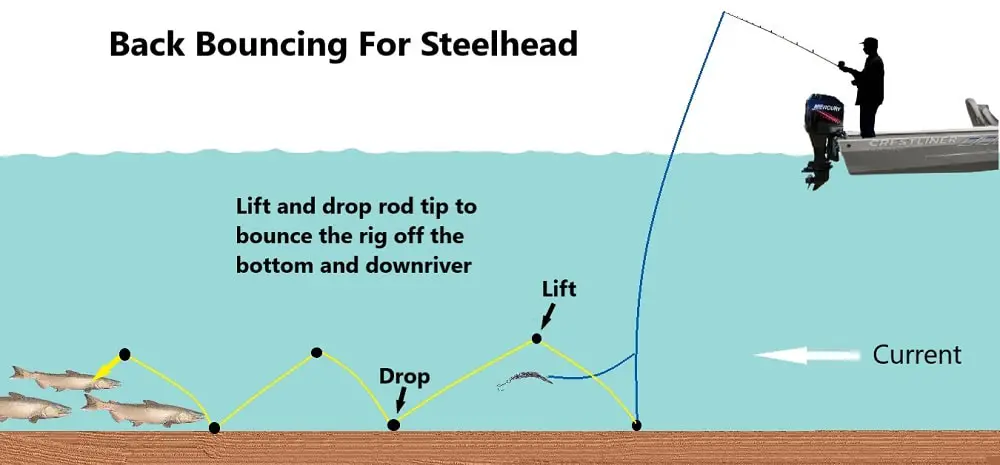
Step One: Drop the weight to the bottom. As the weight reaches the riverbed, you’ll feel a distinctive thud. If bait is your choice, it will start leaving a scent trail.
Step Two: Maintain your rod tip at around eye level. After a short wait of 5 to 10 seconds, raise the rod tip by 4 to 5 feet. At the peak of this lift, let the line free spool out as you lower your rod tip back to eye level and stop the line. This motion elevates your rig and enables the current to gently pull out more line, in turn propelling your setup a tad forward and causing the weight to descend a foot or two downstream.
Step Three: Repeat. This technique should be repeated, gradually allowing your line to extend downriver as far as possible while retaining the ability to sense the weight’s thud and interaction with the riverbed. However, don’t go too far downstream, as you might lose the feel of the weight and potentially miss those precious bites.
Guide Tip: I advise stopping your line when it reaches a 45-degree angle from the water’s surface. Personally, I’m comfortable extending a bit further as long as I can maintain that tactile connection with the weight and any potential bites, but this is when my clients find it difficult to detect bottom.
Step Four: Reel in, pick another line three to five feet to the left or right of where you just drifted, and repeat to effectively cover the water, I’ll discuss covering the water below.
Back Bouncing From Your Boat
For most anglers, back bouncing from a boat is the go-to approach, and for good reason – it’s highly effective.
Anchored Boat: Often, you’ll find the boat anchored upstream from the prime steelhead holding spot. This stationary setup enables you to manipulate the bait’s movement downstream using the rod tip and controlled line spooling.
Moving Boat: Some anglers prefer a slight modification, coupling rod lifts with very slow boat movement downstream. This involves lifting the rod to bounce the bait and intermittently raising the anchor, letting the boat drift around 5 to 10 feet at a time. This approach effectively covers more ground downstream.
Back Bouncing From The Shore or While Wading
If you’re not on a boat, don’t worry, back bouncing can still be successfully executed from the bank or while wading. This can resemble a method known as drift fishing, which uses less weight to ensure your bait maintains a consistent drift.
Wading Out: Wade out carefully until you’re positioned directly upstream from your target Steelhead area. This strategic positioning lets you slowly back bounce the weight precisely into the holding area of the Steelhead. Exercise caution and ensure your wading is safe.
From The Bank: Fishing from the bank can work well if you’re positioned upriver where you can cast across to the prime Steelhead spot and back bounce your way downriver.
Back Bouncing For Steelhead With Bait
Many anglers find back bouncing with bait the preferred way to catch fish since baits release enticing scents that steelhead can detect well before they catch sight of the bait itself. By the time the bait comes into view, it’s hard for steelhead to resist.
Typical bait options include skien, cured eggs, spawn sacks, shrimp, and cut herring. These baits are renowned for their scent dispersion, especially if they’ve been properly cured.
Enhance Your Game With Lil’ Corky And Spin-N-Glo
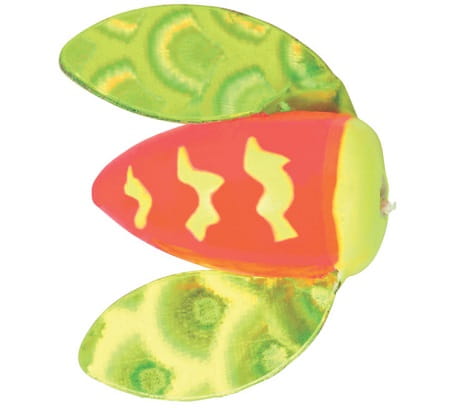
Elevate your back-bouncing game and maybe catch more fish by attaching a Lil’ Corky or a Spin-N-Glo to your leader.
This addition can keep your bait up off the bottom, and it attracts even more steelhead.
Back Bouncing For Steelhead With Lures
Back bouncing is also known to some as plugging for steelhead, and lures, also know as plugs are the go-to bait. Lures can be remarkably effective. Opt for lures like spoons, spinners, crankbaits, and plugs. Among these, plugs stand out as the most popular choice for back bouncing.
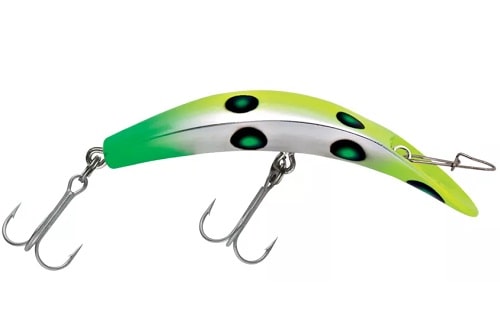
The most popular lures for Back Bouncing are the Kwikfish T12 to T14, Flatfish M2 and T50, and the Yakima Maglips from 3″ to 5 inch.
Back bouncing with plugs comes in two distinct approaches.
First, the traditional method in swifter water involves a weight that secures the lure’s position to the bottom and an anchor boat.
The second method uses less weight and a larger plug that slowly drags the weight along the bottom downstream by the river current, with occasional rod lifts for added lure action.
Deciding On The Optimal Weight
Selecting the right weight for back bouncing hinges on the specific conditions of your fishing location. Your chosen weight should create a distinctive thud when it reaches the riverbed, and it should stay put instead of drifting downstream on its own.
Furthermore, you want a weight that, when lifted from the riverbed, is still light enough that it allows the current to push it 6 to 24 inches downstream.
For faster currents and depths of around 8 feet or more, a 2-ounce ball weight is ideal. In slower waters, opt for a one-ounce to 1.5-ounce ball weight and then adjust as needed.
Favorable Water Conditions For Back Bouncing
Back bouncing truly shines on medium to larger rivers that feature deep holes, drop-offs, ledges, and areas with deeper water and faster water. To maximize success, fish the areas with a current flow akin to a brisk walking pace or faster.
While you can fish depths as shallow as 6 feet, it’s best to fish spots between 8 to 20 feet deep.
Covering The Water Effectively
Whether you’re situated in a securely anchored boat upstream from steelhead and salmon, or you’re standing on the bank or wading, adopting a systematic approach to covering the water is crucial. I’ve found that spreading out your bait in 2 to 3-foot segments, side by side, with each consecutive drift, tends to yield the best results.
Start to fish on one side of the boat, positioning your line as far outward as possible. Gradually fish your way across to the opposite side of the boat.
For wider rivers, the most effective way to cover water the area is by shifting the boat to the side after completely covering the water in the first spot. So basically, move the boat over 20 feet and repeat.
Once you’ve thoroughly fished one location, move to the next fishing spot.
Detecting A Strike And Nailing The Hookset
When dealing with plugs or lures, you can usually anticipate a rather assertive strike that can’t be missed. As soon as you notice the line peeling out, just set that hook hard and fast.
Bait fishing bites can be more subtle, and sometimes you won’t feel the bite. Instead, you’ll notice the rod tip starting to pulsate a bit. Many anglers believe that Steelhead might be gently mouthing or inspecting the bait when you see this. In these instances, the advice is to exercise patience—wait, wait, and wait some more until the line starts pulling out before setting the hook.
Personally, I tend to read the bite, and sometimes, that means I set the hook hard and fast without waiting. If the rod tip displays consistent movement or I feel a slow pull immediately, I don’t hesitate to set the hook.
However, if the rod tip moves and then stops, and does this on and off, it’s often a sign of the steelhead toying with your bait. When this happens, exercise restraint until the steelhead commits and starts pulling before setting that hook.
Essential Gear For Back Bouncing
Let’s delve into the gear that’s essential for successful back-bouncing expeditions.
Rods: Opt for a rod within the 7.5 to 9 feet range. Going longer might hinder your ability to feel the bait and detect bites. A medium to medium-heavy action rod is the way to go, providing that perfect balance of stiffness, responsiveness, and sensitivity needed for hooking into a sizable Steelhead. See Best Rods For Steelhead Fishing.
Reels: Many anglers prefer a low-profile bait casting reel for this technique, as it allows for controlled line release speed during rod lifts and can be used in most situations. However, don’t discount a good spinning reel. Look for a quality reel with ample line capacity and a smooth drag system to tackle those lengthy runs. For spinning reels, a 3500 to 4000 size works best. See Best Reels For Steelhead Fishing.
Line: For your main line, I prefer a 30-pound braided line from reputable brands like Sufix, Tough Line, or PowerPro. You could also use a 12 to 16-pound fluorocarbon or mono line.
Terminal Gear For Your Set-Up
- Swivels: Use a quality barrel swivel – I do not recommend a three-way swivel.
- Hooks: Size 2/0 to size 6, adjusting according to your chosen bait.
- Lead ball weights: Opt for ball weights to minimize snagging on rocks. Other anglers will also use pencil lead. Regardless of which weight you use, have multiple sizes to be sure you have enough weight.
- 6mm Bead: Position this bead above the swivel as a stopper.
- Leader: I use two leader sizes for the setup. 14 to 20 pounds for the leader connected to the bait or lure, which is plenty even for big fish. And a slightly lighter leader that is 2 to 4 pounds lighter for the dropper with the weight. This lighter dropper line ensures that only the weight breaks off in case of a snag.
Back Bouncing Rig For Bait
The key to these bait rigs is using a sliding swivel to attach the leader. I will also use a large loop knot to easily change weight sizes.
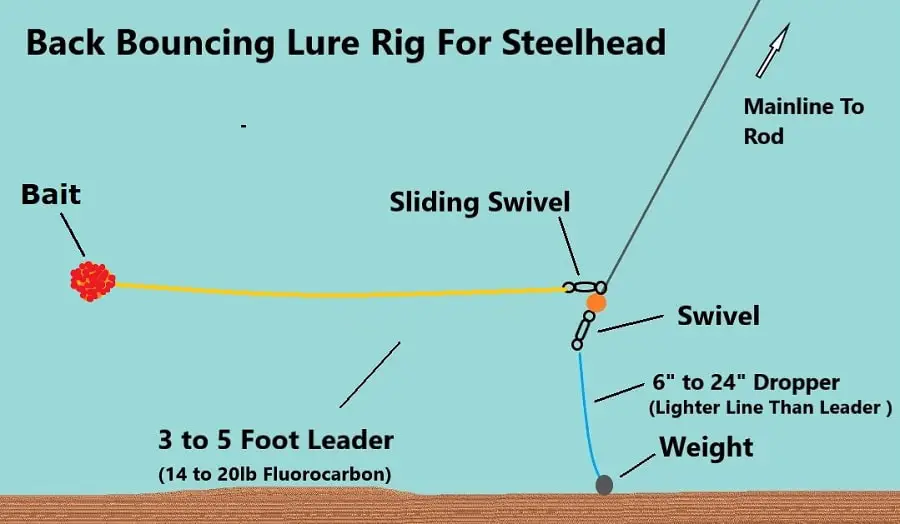
Back Bouncing Rig For Lures and Plugs
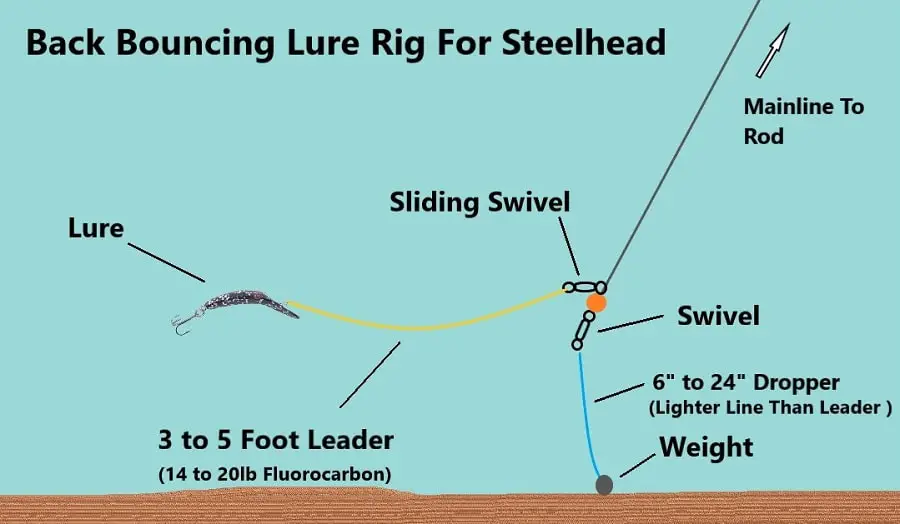
Back Bouncing For Steelhead Q&A
Back bouncing is one of the most effective ways to catch steelhead on bigger rivers around the Great Lakes or anywhere on the West Coast. If you have a question or comment about back bouncing for steelhead, let us know in the comments section below.
Tight Lines
Graham
